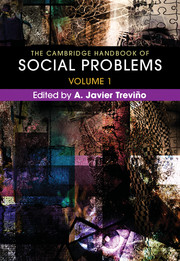Book contents
- The Cambridge Handbook of Social Problems
- The Cambridge Handbook of Social Problems
- Copyright page
- Contents
- About the Contributors
- Introduction
- Part I General Concerns and Orientations in the Study of Social Problems
- Part II Historical and Theoretical Issues in the Study of Social Problems
- Part III Problems of Discrimination and Inequality
- Part IV Problems of Institutions
- Chapter 26 Media and the Construction of Social Problems
- Chapter 27 Family Problems
- Chapter 28 Problems in Education
- Chapter 29 Problems of the Workplace and Workforce
- Chapter 30 Long-Term Unemployment in the United States
- Index
- References
Chapter 27 - Family Problems
from Part IV - Problems of Institutions
Published online by Cambridge University Press: 16 March 2018
- The Cambridge Handbook of Social Problems
- The Cambridge Handbook of Social Problems
- Copyright page
- Contents
- About the Contributors
- Introduction
- Part I General Concerns and Orientations in the Study of Social Problems
- Part II Historical and Theoretical Issues in the Study of Social Problems
- Part III Problems of Discrimination and Inequality
- Part IV Problems of Institutions
- Chapter 26 Media and the Construction of Social Problems
- Chapter 27 Family Problems
- Chapter 28 Problems in Education
- Chapter 29 Problems of the Workplace and Workforce
- Chapter 30 Long-Term Unemployment in the United States
- Index
- References
Summary
The institution of family is the site of a number of social problems. These include intimate partner violence (IPV), child abuse, and elderly abuse. The effects of violence on family members produce immediate negative outcomes and negative outcomes that span over the life course and that reach into the second generation. Other family problems may coexist with family violence. Divorce causes emotional upset. There is a relationship between divorce and poverty for women and children and more negative outcomes for children of divorced parents. Drug abuse and abandonment in families harm adults and children. Society takes steps to lower the incidence and prevalence of each problem, except for divorce. Divorce is common and is generally considered socially acceptable, even though negative outcomes for adults and children are associated with divorce. These family problems are likely to extend into the future.
- Type
- Chapter
- Information
- The Cambridge Handbook of Social Problems , pp. 497 - 512Publisher: Cambridge University PressPrint publication year: 2018



